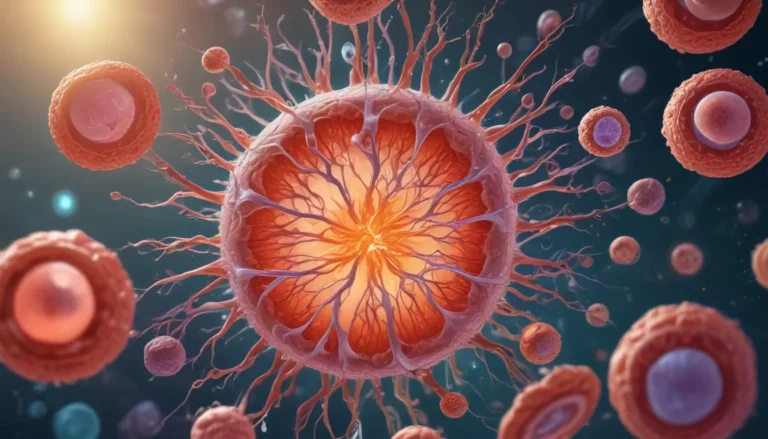A Note About Images: The images used in our articles are for illustration purposes only and may not exactly match the content. They are meant to engage readers, but the text should be relied upon for accurate information.
Are you ready to embark on a journey through the wonders of biology? The BMP (Bone Morphogenetic Protein) signaling pathway is a complex and fascinating system that plays a crucial role in various developmental processes. From embryogenesis to tissue repair and regeneration, this pathway governs the fate of cells and influences our health and well-being in profound ways. In this article, we will explore 14 astounding facts about the BMP signaling pathway that will give you a deeper appreciation for its significance.
The Essence of Cell Communication: BMP Signaling Pathway
The BMP signaling pathway is like a cellular messaging system that controls important processes in our bodies. From building bones to shaping our organs during development, this pathway is essential for cell communication and regulation.
The Discovery of the BMP Signaling Pathway
The BMP signaling pathway was first identified through groundbreaking research in the early 1980s. It was discovered that BMPs, a group of proteins, have the ability to induce bone formation and play a vital role in embryonic development.
Key Players in the Pathway: BMP Ligands
One of the intriguing aspects of the BMP signaling pathway is the presence of several ligands, including Bmp2, Bmp4, and Bmp7, which bind to specific receptors on the cell surface.
Gatekeepers of the Pathway: BMP Receptors
The BMP signaling pathway relies on the presence of two types of receptors, known as type I and type II receptors, that act as gatekeepers for the signaling cascade.
Role in Development: Embryonic and Beyond
The BMP signaling pathway plays a critical role during embryonic development, influencing processes such as cell differentiation, tissue patterning, and organ formation. Additionally, this pathway continues to be active in adult organisms, contributing to tissue maintenance and responses to injury.
Influence on Skeletal System and Neural Development
The BMP signaling pathway is crucial for the development and maintenance of the skeletal system, regulating the formation and differentiation of bones, cartilage, and other skeletal tissues. It also plays a significant role in neural development, influencing processes such as neural tube formation and the differentiation of neurons and glial cells.
Connection to Stem Cell Biology: Regenerative Potential
The BMP signaling pathway is intricately linked to the field of stem cell biology, helping regulate the self-renewal and differentiation of stem cells. This holds promise for regenerative medicine and tissue repair.
Implications in Disease and Therapeutic Potential
Dysregulation of the BMP signaling pathway has been linked to various diseases and disorders, including skeletal abnormalities, cardiovascular diseases, and certain types of cancer. Understanding this pathway opens up exciting avenues for therapeutic interventions, with potential treatments for bone fractures and neurodegenerative diseases.
Cross-talk with Other Signaling Pathways: Complexity and Coordination
The BMP signaling pathway interacts with other crucial signaling pathways, such as Wnt and Notch, to coordinate complex developmental processes. This intricate interplay underscores the complexity and importance of the BMP signaling pathway in biology.
Evolutionary Conservation: Across Species and Time
Remarkably, the BMP signaling pathway is evolutionarily conserved, meaning that its fundamental mechanisms and functions have been well-maintained throughout the course of evolution across different species.
In conclusion, the BMP signaling pathway is an intricate and fascinating biological process that plays a crucial role in development, tissue homeostasis, and disease progression. Understanding this pathway is essential for advancing our knowledge in biology and medicine, paving the way for novel therapeutic interventions and breakthroughs in regenerative medicine. Whether you are a seasoned researcher or a curious novice, the wonders of the BMP signaling pathway are sure to captivate you and inspire further exploration in the field of biology.
FAQs: Exploring Further
-
What is the BMP signaling pathway?
The BMP signaling pathway is a cellular communication pathway that regulates various biological processes, such as embryonic development, tissue homeostasis, and disease progression. -
What is the role of the BMP signaling pathway in embryonic development?
The BMP signaling pathway plays a crucial role in embryonic development by regulating cell proliferation, differentiation, and morphogenesis. -
How does dysregulation of the BMP signaling pathway contribute to disease?
Dysregulation of the BMP signaling pathway can lead to various diseases, including cancer development and progression. -
Are there any therapeutic implications of targeting the BMP signaling pathway?
Yes, targeting the BMP signaling pathway shows promise as a therapeutic strategy for various conditions, such as bone-related disorders and cardiovascular diseases. -
What are some future directions of research in the field of BMP signaling?
Future research aims to further unravel the intricate mechanisms of the BMP signaling pathway and its interactions with other signaling pathways. Investigating its role in tissue regeneration could lead to potential breakthroughs in regenerative medicine.
Unraveling the mysteries of the BMP signaling pathway is just the beginning of your journey into the fascinating world of science. Let the marvels of biology inspire you as you explore the captivations of cellular communication and developmental processes. With each fact uncovered, you are one step closer to understanding the intricate mechanisms that shape life as we know it.






